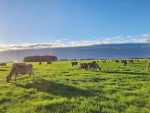In early July close to 300 people gathered in Marlborough for the first ever Organic and Biodynamic Winegrowing Conference.
It was an amazing success, drawing like minded people from throughout the country and speakers from around the world.
While the organisers and OWNZ deserve a huge amount of credit, so too do the god-parents of organic and bio dynamic wine – James and Annie Millton.
Former NZ Winegrower Personalities of the Year, the Millton’s are true pioneers of the expanding organic and biodynamic wine movement.
It was 1984 when the Millton’s began the organic process, finally reaching certification in 1989. They were the first New Zealanders to achieve that status.
But as James pointed out, it was a lonely time. Being a pioneer often is, especially when other producers were looking askance at them. He admits many thought they were crazy to even contemplate such a move and he admits they have spent more than two decades proving everyone right.
“Now it seems everybody wants to be crazy and that is just what this planet needs.”
As he looked out over the conference delegates, he mused on how far the “craziness” had spread.
“Who would have believed 20 years ago we would have had this many people attending an organic and biodynamic winegrowing conference.”
These days the Millton’s have been joined by 103 other growers who have gained organic certification, 12.5 percent of all growers in New Zealand. Not bad in just a couple of decades. And the numbers are growing.
With an image of clean and green, New Zealand has an enviable image in the world of wine. Our prices in export markets reflect that image – our land is pure, our wine is pure and what’s more it is of the highest quality. OWNZ plays a vital role in that image, and its growth on a national scale is vitally important to the future of the New Zealand wine industry.
OWNZ has a goal of 20 percent by 2020. Twenty percent of all our vineyards being organically certified in the next five years. Millton believes that will be achieved. At this stage the figure of organically certified vineyard stands at 5.4 percent, or 1906 hectares. While that may seem a long way from the 20 percent OWNZ would like by 2020, the growth in the past 15 years has been phenomenal. In 1999 there were only 54 hectares of certified organic vineyards. In 2007 there were 225 hectares. Now there are 1,906. The move to organics is growing and growing at a spectacular rate.
With the Organic Focus Vineyard Project comparing the production costs between conventional and organic now complete, many more are likely to follow in the Millton’s footsteps.
And while the goal of 20/20 may seem a tough nut to crack, James is not concerned. He believes the quality of the wines emanating from organic and biodynamic vineyards will be enough to convince growers.
“My mantra is that 100 percent of the quality wines will be coming from integrated or fully organic/biodynamic wines by 2020. Watch this space.”
We have more from the conference in this issue of NZ Winegrower, including just where we sit in the world of organic winegrowing, the market for these wines and how organic growers can control nitrogen in their vineyards.
They along with an array of other stories make up this issue, which is the largest NZ Winegrower in 10 years. Enjoy!





